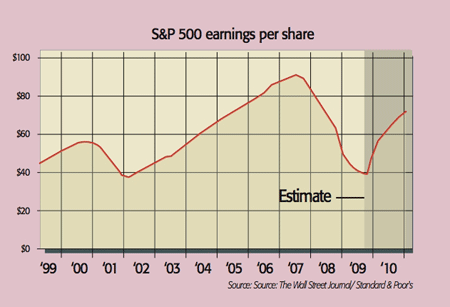All eyes are on Wall Street now that the reporting season for third-quarter earnings has begun. Earnings surprised on the upside in the first and second quarters and it will be a similar story this season, says the FT's John Authers. In recent years firms have become adept at lowering expectations and then surprising investors positively by beating them.
Indeed, most of the market's gains come when "manufactured surprises are revealed", says Authers. Andrew Lapthorne of Socit Gnrale found last year that since 2000, the S&P has gained an annualised average of 2.3% during the first-, second- and third-quarter reporting seasons. Outside these periods, the S&P was down on average by an annualised 1.2%.
And the bar isn't high this season, with S&P profits expected to slide by 25% year-on-year. "I don't think it's going to be a problem" for firms to "at least match" expectations, says Peter Cardillo of Avalon Partners. The weak dollar will also help, given that S&P 500 firms last year made 48% of their sales abroad. So the rally looks set to keep going.
MoneyWeek
Subscribe to MoneyWeek today and get your first six magazine issues absolutely FREE

Sign up to Money Morning
Don't miss the latest investment and personal finances news, market analysis, plus money-saving tips with our free twice-daily newsletter
Don't miss the latest investment and personal finances news, market analysis, plus money-saving tips with our free twice-daily newsletter

That's all very well for now. But the longer-term earnings outlook in the new year is troubling. Analysts expect 35% annual growth in 2010, the fastest rate in more than 20 years, with S&P 500 firms expected to notch up a collective $73 a share, says Mark Gongloff in The Wall Street Journal. Yet a "V-shaped profit recovery" is unlikely.
So far earnings have been boosted by cost cutting, which can't go on forever. Investors will now increasingly look for revenue growth, yet analysts still expect an "L-shaped" revenue pattern, with growth of just 5%-10% next year, says Gongloff. Consumption is key to revenue growth. Yet as David Rosenberg of Gluskin Sheff points out, this is hardly going to take off with consumers deleveraging: they have paid back a record amount of debt over the past year.
So if sales are lacklustre, margins will have to rise fast a tall order as they are already near historical highs. High valuations (the S&P is on a trailing p/e of 28) also increase the scope for disappointment. Overoptimistic markets are set to land with a bump in 2010.
Get the latest financial news, insights and expert analysis from our award-winning MoneyWeek team, to help you understand what really matters when it comes to your finances.
MoneyWeek is written by a team of experienced and award-winning journalists, plus expert columnists. As well as daily digital news and features, MoneyWeek also publishes a weekly magazine, covering investing and personal finance. From share tips, pensions, gold to practical investment tips - we provide a round-up to help you make money and keep it.
-
 Is US stock market exceptionalism over?
Is US stock market exceptionalism over?US stocks trailed the rest of the world in 2025. Is this a sign that a long-overdue shift is underway?
-
 A reckoning is coming for unnecessary investment trusts
A reckoning is coming for unnecessary investment trustsInvestment trusts that don’t use their structural advantages will find it increasingly hard to survive, says Rupert Hargreaves

